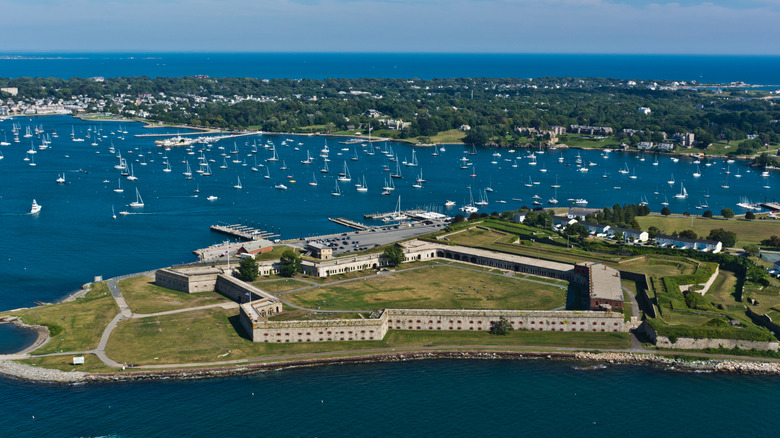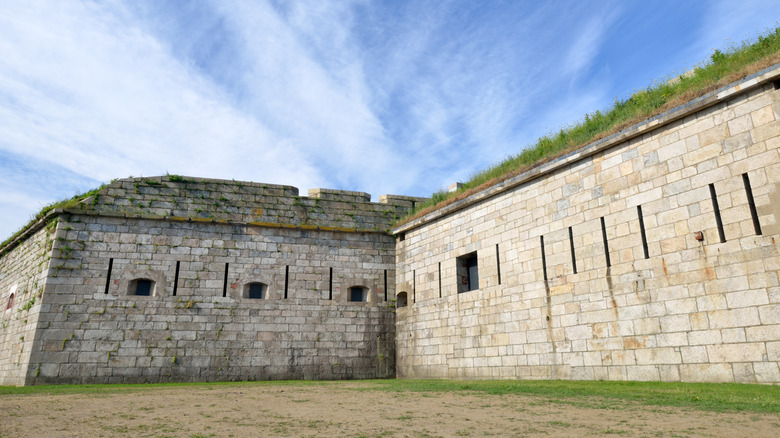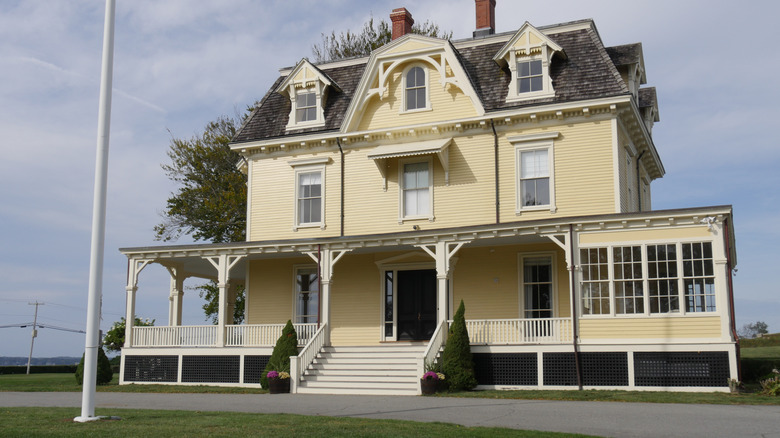Rhode Island's Stunning State Park Is A Historic Gem With Serene Trails On The New England Coast
The charming nooks of America's smallest state hold some of the country's biggest wonders. In the little riverfront city of Woonsocket, Rhode Island, amid its historic charm, you'll find the U.S.'s largest collection of frescoes. In the historic district of Newport stands the largest cluster of preserved colonial buildings in the country. At the tip of Newport's curled peninsula, there's another incredible place you need to visit at least once on a trip to Rhode Island and another record-breaker: Fort Adams State Park is the country's largest coastal fortification. Covering about 105 acres, the fort includes masterfully designed ramparts in a pentagon shape, casemates, underground tunnels, and walking trails that trace the bay.
The current fort was built between 1824 and 1857, but the original fort on site dates back to 1799. It was part of a plan known as the Third System of fortifications that was conceived following the War of 1812 in an effort to better protect America's eastern coast. Fort Adams became a magnum opus of the system, with a mix of earth-filled ramparts, underground listening galleries, and counterscarp galleries, all of which were quite unique to fortification systems of the time. Much of the fort's stonework is still preserved, and you can explore the fort, the living quarters of its soldiers, and its parade ground today on a guided or self-guided tour.
See the hidden tunnels and soaring walls of Fort Adams
The site of Fort Adams had a role in many of America's biggest wars — the War of 1812, the American Civil War, and both World Wars among them. But, despite its strategic significance, it never was attacked. The grounds of the fort were used for military training, housing soldiers, and serving as a command center. Originally, the fort was a brick structure created after the British army besieged Newport during the Revolutionary War. The fort was named after President John Adams and officially opened in 1799, but most of the initial structure was demolished, aside from traces of some early cannon emplacements.
After the War of 1812, the country stepped up its coastal defenses with the Third System, overseen by American engineer Joseph Totten. Totten designed most of the presently standing Fort Adams, including its irregular pentagonal shape, which was deliberately planned so that each wall section could be protected by an adjacent wall. The new fort was also massive: It could house about 2,400 people, over 450 cannons, and was self-sustaining, with food stores and medical care facilities. You can see some of the living quarters and look out through the cannon slots in the restored casemates.
Both guided and self-guided tours allow you to climb up the towering fort walls to get sweeping views over Newport Harbor and out to Rose Island, a historic Rhode Island lighthouse secluded in the bay. But one of the most intriguing elements of the fort's design is only accessible if you book a guided tour: the underground tunnels. There are over 3,000 feet of these underground tunnels, which were part of the fort's ingenious design to listen in on potential underground activity by enemies.
Explore Fort Adams State Park beyond the fort
Aside from the main fortification, Fort Adams State Park includes several other historic buildings, walking paths, a beach, and tons of opportunities for recreation. One of the most interesting buildings on site is the old guardhouse, built in the Greek Revival style from granite. Another is the 1873-built Eisenhower House, a magnificent mansion that was formerly the president's summer residence.
The main walking trail at the park is the 2.5-mile Fort Adams Bay Walk. It loops around the perimeter of the park, hugging the bay with great views of the water and Newport Bridge. As you walk on the eastern side of the peninsula, you'll pass Fort Adams Beach. You can go swimming here, and there are restrooms, showers, and picnic tables available. There's also Sail Newport, a public sailing center that's based in the park. Rent a small sailboat or take a lesson here in the summer, or bring your own kayak to take out onto the launch.
Importantly, Fort Adams State Park is closed during the end of July and early August, but for a reason that might be worth attending in itself: festival season. The park hosts both the Newport Folk Festival, where Bob Dylan made his iconic electric debut in 1965, and the similarly historic Newport Jazz Festival. For those flying in, Fort Adams is just about an hour drive from the Rhode Island T.F. Green International Airport outside of Providence, and there's free parking outside the entrance.


